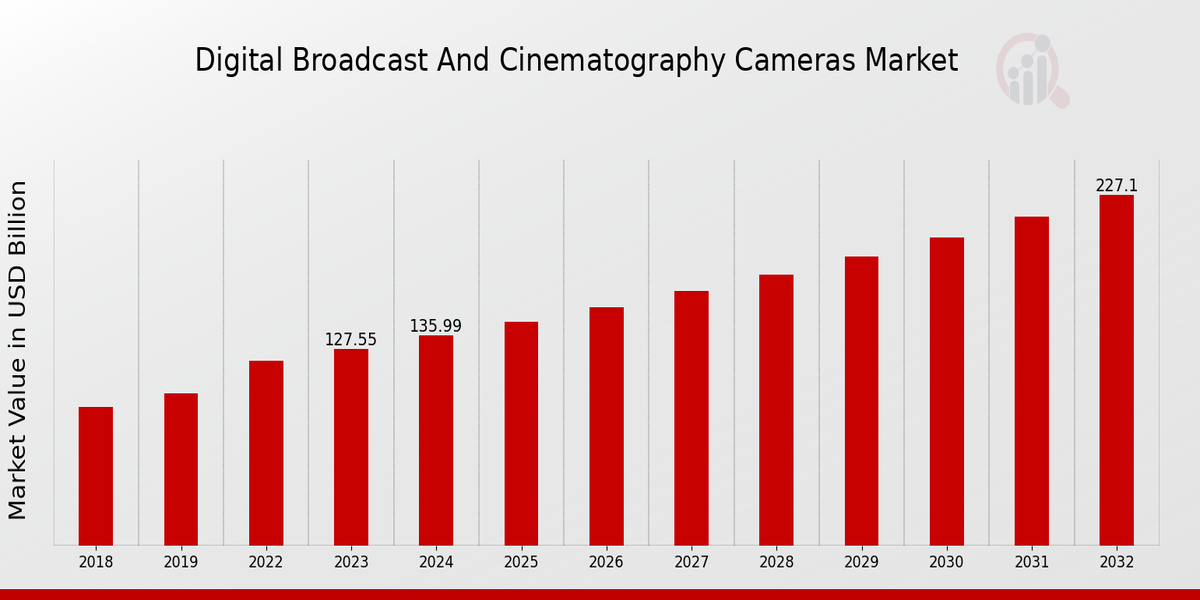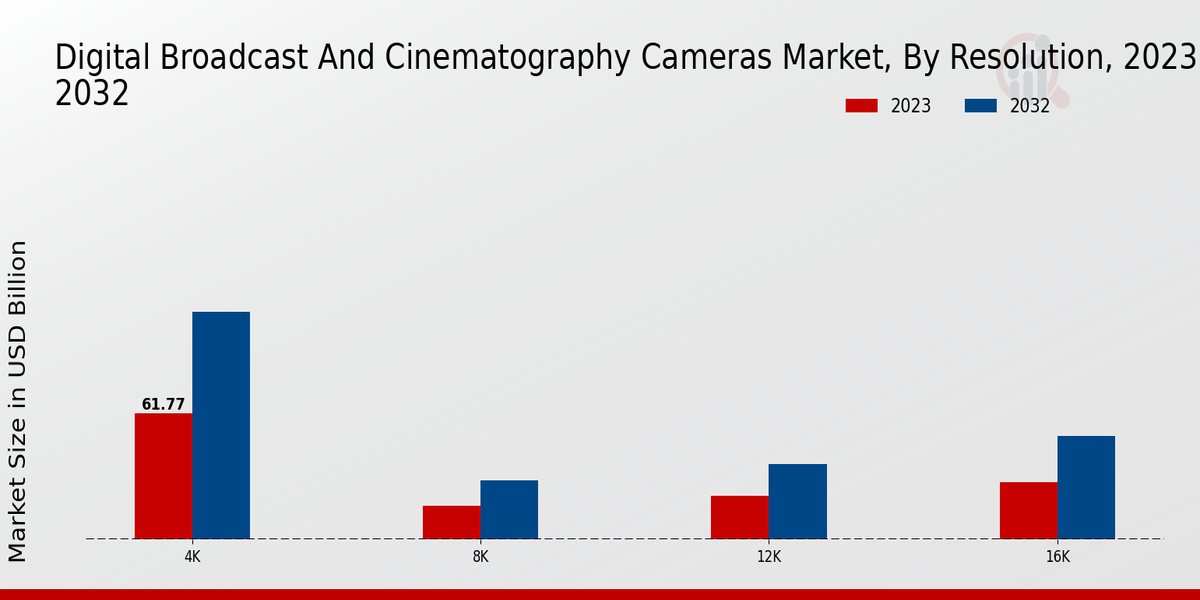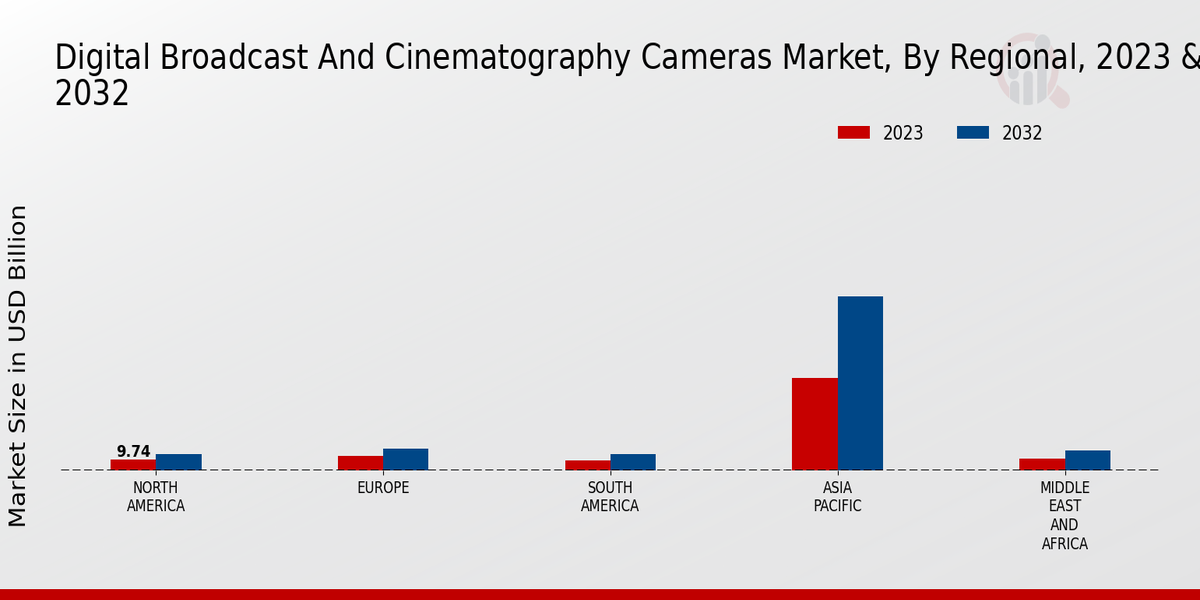Digital Broadcast And Cinematography Cameras Market Overview
As per MRFR analysis, the Digital Broadcast And Cinematography Cameras Market Size was estimated at 119.63 (USD Billion) in 2022. The Digital Broadcast And Cinematography Cameras Market Industry is expected to grow from 127.55(USD Billion) in 2023 to 227.1 (USD Billion) by 2032. The Digital Broadcast And Cinematography Cameras Market CAGR (growth rate) is expected to be around 6.62% during the forecast period (2024 - 2032).
Key Digital Broadcast And Cinematography Cameras Market Trends Highlighted
Digital broadcast and cinematography cameras are witnessing a surge in demand due to the proliferation of streaming services and the growing popularity of online video content. These cameras provide superior image quality and flexibility, making them ideal for high-end productions and live broadcasts.
Rapid technological advancements are driving the market, with manufacturers focusing on developing cameras with enhanced sensors, improved low-light capabilities, and advanced autofocus systems. Additionally, the increasing adoption of cloud-based workflows and remote production techniques is creating opportunities for camera manufacturers to integrate advanced features and connectivity options into their cameras.
The market also benefits from the growing demand for immersive content, such as virtual reality and 360-degree videos. These content formats require cameras with specific capabilities, such as high-resolution sensors and wide-angle lenses, further fueling the growth of the digital broadcast and cinematography camera market.

Source: Primary Research, Secondary Research, MRFR Database and Analyst Review
Digital Broadcast And Cinematography Cameras Market Drivers
Increasing Demand for High-Quality Content
The development of digital cinema cameras was prompted by the progression in telecommunications. These are the core innovations within the field that are giving the entertainment sector a do-over and bringing along with it all sorts of opportunities, ventures, projects and new ideas which had been functionally inactive due to previous limitations. Having been mentioned, it is important to note that there has always been the constant pursuit of improvement across all these areas.
With the increased popularity of the World Wide Web came a need for more people to engage in higher quality filming as content creators even further fuel the demand for camera cinematographers which means spending countless hours in front of the camera.
Technological Advancements and Innovation
Technological advancements and innovation play a crucial role in driving the growth of the Digital Broadcast And Cinematography Cameras Market Industry. Camera manufacturers are continuously pushing the boundaries of technology to develop cameras with enhanced capabilities and features. The integration of artificial intelligence (AI), machine learning (ML), and cloud-based workflows is transforming the way cameras are used in the production process.
AI-powered features, such as autofocus systems, object tracking, and image stabilization, enhance the efficiency and precision of camera operation. Cloud-based workflows enable seamless collaboration, remote editing, and storage, streamlining the production process and reducing overall costs.
Expansion of Emerging Markets
The expansion of emerging markets presents significant growth opportunities for the Digital Broadcast And Cinematography Cameras Market Industry. Rapidly developing countries, particularly in Asia-Pacific and Latin America, are experiencing a surge in demand for digital broadcast and cinematography cameras. The growing middle class in these regions has a rising disposable income, leading to increased spending on entertainment and media consumption.
Local production companies and content creators are investing in high-quality cameras to cater to the growing demand for local content. Additionally, government initiatives and policies aimed at promoting domestic film and television industries are further driving the growth of the market in emerging economies.
Digital Broadcast And Cinematography Cameras Market Segment Insights
Digital Broadcast And Cinematography Cameras Market Resolution Insights
The resolution segment plays a crucial role in shaping the Digital Broadcast And Cinematography Cameras Market. As the demand for higher-quality content continues to rise, cameras with higher resolutions are becoming increasingly popular. 4K resolution, with four times the resolution of 1080p, has become the standard for professional broadcasting and cinematography. In 2024, the 4K segment is expected to account for over 60% of the Digital Broadcast And Cinematography Cameras Market revenue. The growing popularity of 4K streaming services, such as Netflix and Amazon Prime Video, is driving the demand for 4K cameras.
8K resolution, with even higher resolution than 4K, is still in its early stages of adoption, but it is expected to gain traction in the coming years. In 2024, the 8K segment is expected to account for over 15% of the Digital Broadcast And Cinematography Cameras Market revenue. The adoption of 8K technology is being driven by the development of new 8K televisions and the increasing availability of 8K content. 12K and 16K resolutions are still in their infancy, but they have the potential to revolutionize the industry. These resolutions offer even higher levels of detail, which could make them ideal for applications such as virtual reality and augmented reality.
As these technologies continue to develop, they are expected to gain a larger share of the Digital Broadcast And Cinematography Cameras Market. The resolution segment is expected to continue to grow in the coming years, driven by the demand for higher-quality content. As new technologies emerge, the segment is expected to evolve, with new resolutions and features being introduced to meet the needs of the market.

Source: Primary Research, Secondary Research, MRFR Database and Analyst Review
Digital Broadcast And Cinematography Cameras Market Sensor Type Insights
The Digital Broadcast And Cinematography Cameras Market is segmented by Sensor Type into CMOS, CCD, and Foveon. Among these, the CMOS segment is expected to hold the largest market share in 2023, accounting for over 90% of the market. This dominance is attributed to the superior image quality, low power consumption, and compact size of CMOS sensors. The CCD segment is expected to decline in market share over the forecast period due to the increasing popularity of CMOS sensors. Foveon sensors are expected to witness moderate growth, owing to their unique design that offers higher color accuracy and dynamic range.
Digital Broadcast And Cinematography Cameras Market Lens Mount Insights
The Lens Mount segment plays a crucial role in the Digital Broadcast And Cinematography Cameras Market, influencing industry growth. Among the key players in this segment are PL, EF, E, MFT, and B4. PL (Positive Lock) mount, with a market share of around 35% in 2023, is widely used in high-end cinematography due to its durability and ability to withstand heavy lenses. EF (Electro-Focus) mount, with an estimated market share of 29%, is popular among DSLR and mirrorless cameras. E-mounts, commonly found in Sony cameras, hold a market share of approximately 20% and are known for their compact size and versatility.
MFT (Micro Four Thirds) mount, with a market share of 12%, is prevalent in compact system cameras and offers a wide range of lens options. B4 mount, primarily used in broadcast cameras, accounts for around 4% of the market share. The Lens Mount segment is expected to witness steady growth in the coming years, driven by the increasing demand for high-quality video content and the adoption of advanced camera technologies.
Digital Broadcast And Cinematography Cameras Market Dynamic Range Insights
The dynamic range segment in the Digital Broadcast and Cinematography Cameras Market is characterized by the camera's ability to capture a wide range of light and dark tones within a single image. Higher dynamic range cameras produce images with greater depth and detail and are particularly valuable in capturing scenes with both bright and dark areas. The 8-bit dynamic range is the most basic level and is found in entry-level cameras. It can capture 256 shades of gray, which is sufficient for most basic applications. The 10-bit dynamic range offers a significant improvement, with 1,024 shades of gray.
This allows for more subtle gradations in tone and is particularly useful in capturing scenes with high contrast. The 12-bit dynamic range is even more advanced, with 4,096 shades of gray. This provides even greater detail and depth in images and is ideal for professional cinematography and high-end photography. The 16-bit dynamic range is the highest level available and can capture 65,536 shades of gray. This is the ultimate in dynamic range and is used in specialized applications such as scientific imaging and medical imaging. The Digital Broadcast and Cinematography Cameras Market revenue for the dynamic range segment is expected to grow significantly in the coming years, driven by the increasing demand for high-quality images in both broadcasting and cinematography.
Digital Broadcast And Cinematography Cameras Market Frame Rate Insights
The Digital Broadcast And Cinematography Cameras Market is segmented by Frame Rate into 24fps, 30fps, 60fps, 120fps, and 240fps. Among these, the 24fps segment is expected to hold the largest market share in 2023, owing to its widespread use in filmmaking and television production. The 30fps segment is also expected to witness significant growth, driven by its adoption in live sports broadcasting and video conferencing. The 60fps segment is gaining popularity in gaming and high-speed videography applications. The 120fps and 240fps segments are expected to grow rapidly in the coming years, driven by the increasing demand for slow-motion capture and high-quality video content.
Digital Broadcast And Cinematography Cameras Market Regional Insights
The Digital Broadcast And Cinematography Cameras Market is segmented into North America, Europe, APAC, South America, and MEA. North America is expected to hold the largest market share in 2023, owing to the presence of major players in the region and the increasing adoption of digital broadcast and cinematography cameras by broadcasters and filmmakers. Europe is expected to be the second largest market, driven by the growing demand for high-quality video content and the presence of a large number of production companies. APAC is expected to be the fastest-growing market due to the increasing demand for digital broadcast and cinematography cameras from emerging markets such as China and India. South America and MEA are expected to have a relatively smaller market share but are expected to grow at a steady pace over the forecast period.

Source: Primary Research, Secondary Research, MRFR Database and Analyst Review
Digital Broadcast And Cinematography Cameras Market Key Players And Competitive Insights:
Major players in the Digital Broadcast And Cinematography Cameras Market industry are continuously striving to develop innovative and advanced products to meet the evolving demands of the market. Leading Digital Broadcast And Cinematography Cameras Market players are investing heavily in research and development to enhance the features and capabilities of their cameras, such as higher resolution, improved low-light performance, and more efficient workflows. The Digital Broadcast And Cinematography Cameras Market development is driven by the increasing adoption of digital technologies in the broadcast and cinematography industries.
The competitive landscape of the Digital Broadcast And Cinematography Cameras Market is characterized by the presence of both established and emerging players. Established players have a strong brand presence and a wide distribution network while emerging players are focused on offering niche products and innovative solutions. The Digital Broadcast And Cinematography Cameras Market Competitive Landscape is expected to remain competitive in the coming years, with key players focusing on strategic partnerships, acquisitions, and product launches to gain market share.
Sony is a leading player in the Digital Broadcast And Cinematography Cameras Market, known for its high-quality and innovative products. The company offers a wide range of cameras, including professional camcorders, cinema cameras, and interchangeable-lens cameras. Sony's cameras are trusted by professionals in the broadcast, cinematography, and photography industries. The company has a strong presence in key markets around the world and is committed to providing cutting-edge solutions to meet the evolving needs of its customers. Sony's recent developments include the launch of the VENICE 2 cinema camera, which offers advanced capabilities such as 8K resolution and a wide color gamut.
Blackmagic Design is another major player in the Digital Broadcast And Cinematography Cameras Market. The company is known for its affordable and user-friendly products that cater to a wide range of users, from hobbyists to professionals. Blackmagic Design offers a comprehensive lineup of cameras, including cinema cameras, broadcast cameras, and live production switchers. The company's products are popular among filmmakers, broadcasters, and live event producers. Blackmagic Design's recent developments include the launch of the URSA Mini Pro 12K camera, which offers high-resolution 12K capture and advanced features at an affordable price.
Key Companies in the Digital Broadcast And Cinematography Cameras Market Include
- Olympus Corporation
- ARRI
- Leica Camera AG
- Phase One
- Nikon Corporation
- EOS Imaging
- Mamiya Digital Imaging
- FUJIFILM Holdings Corporation
- Blackmagic Design
- Canon Inc.
- Sony
- Red Digital Cinema Camera Company
- Hasselblad
- Panasonic Corporation
Digital Broadcast And Cinematography Cameras Market Industry Developments
The Digital Broadcast And Cinematography Cameras Market is projected to reach a valuation of approximately USD 227.1 billion by 2032, advancing at a 6.62% CAGR from 2024 to 2032. The market expansion is primarily attributed to the surging adoption of digital cameras in the broadcast and cinematography industries, coupled with the growing popularity of streaming services and online video content. Additionally, technological advancements, such as the integration of AI and machine learning in cameras, are further driving market growth by enhancing camera capabilities and streamlining workflows. Furthermore, the increasing demand for high-quality video content from consumers is fueling the market expansion.
Digital Broadcast And Cinematography Cameras Market Segmentation Insights
- Digital Broadcast And Cinematography Cameras Market Resolution Outlook
- 4K
- 8K
- 12K
- 16K
- Digital Broadcast And Cinematography Cameras Market Sensor Type Outlook
- CMOS
- CCD
- Foveon
- Digital Broadcast And Cinematography Cameras Market Lens Mount Outlook
- PL
- EF
- E
- MFT
- B4
- Digital Broadcast And Cinematography Cameras Market Dynamic Range Outlook
- 8-bit
- 10-bit
- 12-bit
- 16-bit
- Digital Broadcast And Cinematography Cameras Market Frame Rate Outlook
- 24fps
- 30fps
- 60fps
- 120fps
- 240fps
- Digital Broadcast And Cinematography Cameras Market Regional Outlook
- North America
- Europe
- South America
- Asia Pacific
- Middle East and Africa
Digital Broadcast And Cinematography Cameras Market Report Scope
|
Report Attribute/Metric
|
Details
|
|
Market Size 2022
|
119.63(USD Billion)
|
|
Market Size 2023
|
127.55(USD Billion)
|
|
Market Size 2032
|
227.1(USD Billion)
|
|
Compound Annual Growth Rate (CAGR)
|
6.62% (2024 - 2032)
|
|
Report Coverage
|
Revenue Forecast, Competitive Landscape, Growth Factors, and Trends
|
|
Base Year
|
2023
|
|
Market Forecast Period
|
2024 - 2032
|
|
Historical Data
|
2019 - 2023
|
|
Market Forecast Units
|
USD Billion
|
|
Key Companies Profiled
|
Olympus Corporation, ARRI, Leica Camera AG, Phase One, Nikon Corporation, EOS Imaging, Mamiya Digital Imaging, FUJIFILM Holdings Corporation, Blackmagic Design, Canon Inc., Sony, Red Digital Cinema Camera Company, Hasselblad, Panasonic Corporation.
|
|
Segments Covered
|
Resolution, Sensor Type, Lens Mount, Dynamic Range, Frame Rate, Regional.
|
|
Key Market Opportunities
|
1 4K and 8K video capture2 Increased demand for content3 Growing popularity of live streaming4 Virtual and augmented reality applications5 Adoption of cloud technology
|
|
Key Market Dynamics
|
1 Increasing demand for high-quality video content2 Growing popularity of streaming services3 Technological advancements in camera sensors and optics4 Rise of virtual and augmented reality5 Expanding applications in healthcare and education
|
|
Countries Covered
|
North America, Europe, APAC, South America, MEA
|
Frequently Asked Questions (FAQ) :
The Digital Broadcast And Cinematography Cameras Market is expected to reach a valuation of USD 227.1 Billion by 2032, exhibiting a CAGR of 6.62% from 2024 to 2032.
North America and Europe are the dominant regions in the Digital Broadcast And Cinematography Cameras Market, collectively accounting for over 60% of the market revenue. The Asia Pacific region is projected to witness the highest growth rate during the forecast period due to the increasing demand for digital content production in emerging economies.
Digital Broadcast And Cinematography Cameras are widely used in various applications, including television and film production, live events broadcasting, sports coverage, and digital content creation for online platforms.
Major players in the Digital Broadcast And Cinematography Cameras Market include Sony, Canon, Panasonic, Blackmagic Design, and ARRI. These companies offer a range of cameras tailored to different applications and budgets.
The growth of the Digital Broadcast And Cinematography Cameras Market is driven by factors such as the increasing popularity of digital content, the adoption of advanced technologies like 4K and 8K resolution, and the growing demand for live event broadcasting.
Challenges faced by the Digital Broadcast And Cinematography Cameras Market include intense competition, rapid technological advancements, and the impact of economic downturns on production budgets.
Key trends shaping the future of the Digital Broadcast And Cinematography Cameras Market include the adoption of cloud-based workflows, the integration of artificial intelligence (AI) in camera systems, and the growing popularity of virtual and augmented reality (VR/AR) content creation.
The COVID-19 pandemic had a significant impact on the Digital Broadcast And Cinematography Cameras Market, leading to a decline in demand due to production shutdowns and event cancellations. However, the market is expected to recover as production activities resume and new applications for digital content emerge.
Growth opportunities for the Digital Broadcast And Cinematography Cameras Market lie in the expansion of emerging markets, the development of new camera technologies, and the adoption of digital content creation across various industries.
The Digital Broadcast And Cinematography Cameras Market is projected to grow at a CAGR of 6.62% from 2024 to 2032, reaching a valuation of USD 227.1 Billion by 2032.

















